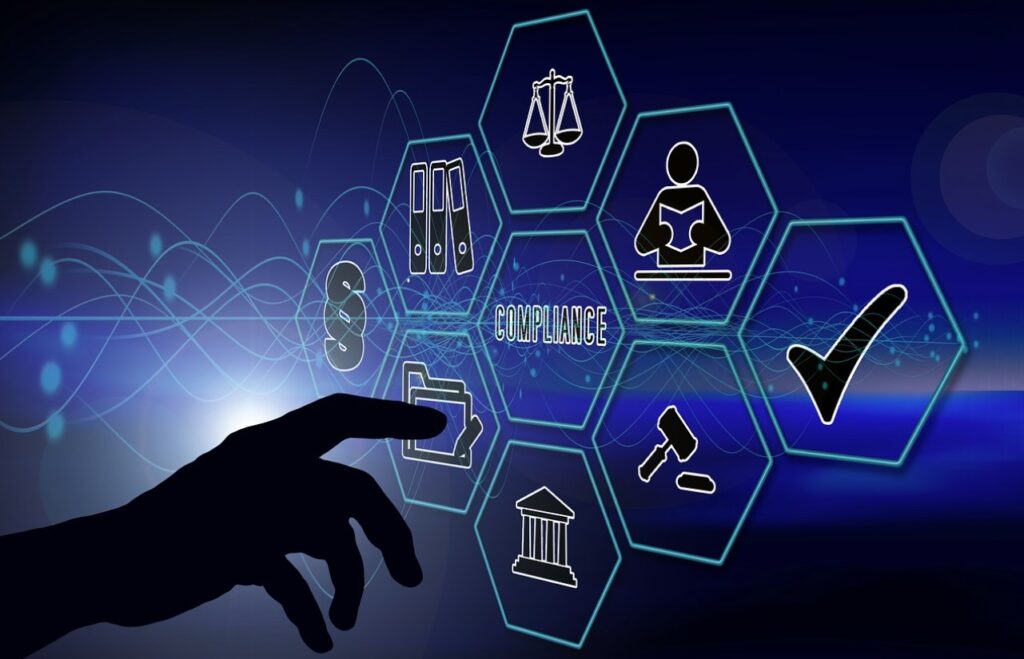Today’s business environment is constantly changing due to the emergence of new technologies, sophisticated frameworks, and a growing hybrid work environment. While these changes offer you a competitive advantage and increase the efficiency of operations, they also open up new risks.
Moreover, regulations and standards are evolving to monitor these risks. Your organization may have to create new security and governance policies to meet these regulations. In such a fluid environment, managing Governance, Risk, and Compliance (GRC) is not easy; and this is where specialized GRC platforms help.
Here is our list of the best GRC Software Platforms:
- Alyne from Mitratech Fully automated GRC platform that helps with integrated risk management and compliance. Its dynamic dashboard and reports enable you to make informed decisions.
- Corporater Flexible GRC platform that integrates data from different sources to provide a complete picture of risks for your business. It also offers a wide range of capabilities for governance and compliance.
- Vanta Enables you to accelerate the implementation of your GRC programs and activities. Its monitoring and reporting capabilities also help stay on top of adherence rates.
- Hyperproof GRC platform enables you to manage risk and compliance with its powerful features like automated workflows, extensive audits, and risk mitigation.
- Compliancy Group Automated compliance software is designed primarily for healthcare companies. Its tailored features help organizations comply with standards like HIPAA, OSHA, and SOC 2.
- SAP GRC Comprehensive solution that helps organizations assess and manage risks and compliance across the entire organization.
- Protecht Group Cost-effective GRC platform to manage risks, meet compliance, and improve operational resilience.
- MetricStream SaaS product that connects governance, risk, and compliance throughout the organization to help businesses make risk-aware decisions.
- IBM OpenPages Integrated GRC tool simplifies data governance through its AI-powered features and extensive capabilities. It also helps manage compliance across the entire organization.
- ServiceNow GRC platform helps manage your governance framework and transforms inefficient risk processes into an integrated risk mitigation program.
The best GRC Software Platforms
Our methodology for selecting a GRC Software Platform:
With so many GRC tools, it’s hard to find the one that best meets your needs. To ease this process, we have shortlisted the best GRC tools based on the below criteria.
- Ability to comply with different regulations.
- Identify risks across different projects, departments, and processes.
- Generate insightful reports that can help executives make informed decisions.
- Automate the auditing process.
- Free demo or trial to assess a tool’s capabilities and fit without incurring a cost.
- Usability and customer support.
Next, let’s jump to a detailed review of each tool.
1. Alyne from Mitratech
Alyne is a cloud-based GRC platform that uses AI to continuously monitor your risks and compliance. With its advanced tools, it streamlines the implementation of governance policies and provides 360-degree visibility into their impact on your organization.
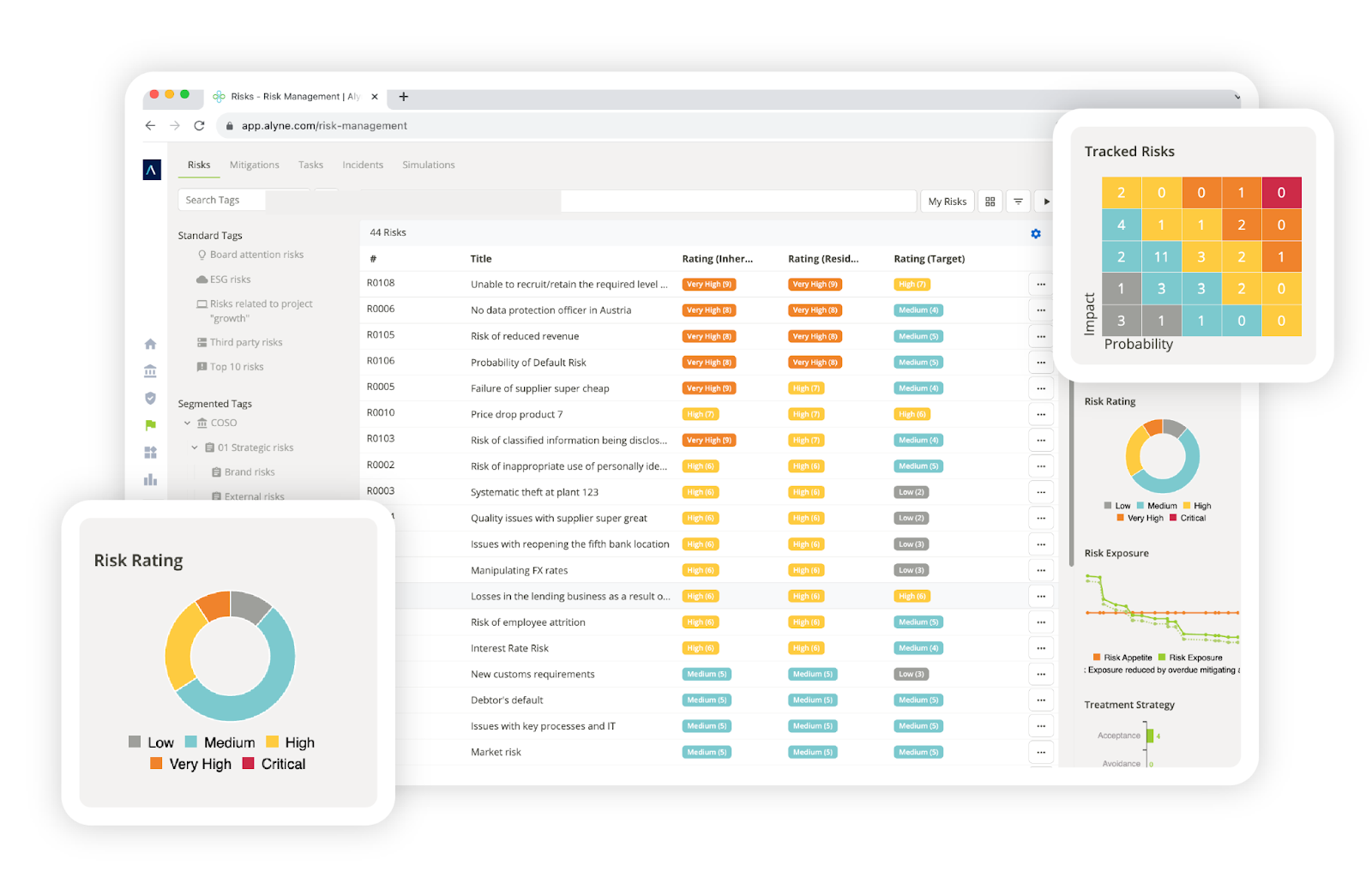
Source: Mitratech
Let’s now look at some key features of Alyne.
Automates Workflows and Processes
A highlight of Alyne is its automation capabilities that increase efficiency while reducing the resources you need for governance. With the right configuration, you can ensure that your data and documents follow the established guidelines. Similarly, this GRC tool can automatically ensure that only certain roles can perform specified activities like approving requests, accessing sensitive data, and more. Such workflows protect your organization from risks like unauthorized access while ensuring that operations follow the organization’s policies.
Extensive Coverage of Compliance Standards
Another helpful feature of Alyne is that it covers a wide range of regulations and standards. Some popular ones that you can comply with include ISO 27001, SOC 2, NIST, DFAST, SOX, TRIM, SS1/22, SS2/22, and more. As these standards span across multiple sectors and industries, Alyne can be a handy tool for all organizations. Furthermore, Alyne offers 1,500 out-of-the-box templates that are mapped to different regulations and controls. You can customize these templates to meet your specific needs, making Alyne a good choice for both small businesses and large enterprises.
Leverages New Technologies
Alyne uses AI and ML to help identify risks and non-compliance within your organization. The advantage of using these technologies is they continuously learn and adapt to meet your requirements, and can even generate insights on the emerging risks. Besides AI and ML, Alyne also integrates with other providers like SecurityScorecard and Black Kite to manage vendor risks and maintain visibility of your organization’s risk exposure.
Overall, Alyne has all the features you need to ensure visibility over your governance policies, risk mitigation, and compliance with regulations and standards.
Pros:
- Excellent support
- Highly customizable to meet your specific needs,
- It allows you to run with pre-defined maturity levels to better assess risks.
- Alyne comes with built-in graph databases to help stakeholders understand the dependencies between resources.
Cons:
- No free trial.
EDITOR'S CHOICE
Alyne is our top pick for GRC platforms as it helps teams easily understand risks within their work context and empowers organizations to address them. Its use of AI and ML interprets your organization’s policies in the context of the likely risks and the applicable regulations. Its ease of use coupled with no-code configuration and workflows makes it ideal for users of all technical levels.
Download: Request a Demo
Official Site: https://mitratech.com/demo/alyne/
2. Corporater
Corporater is a business-integrated GRC solution that offers flexible deployment options to meet your specific needs. More importantly, it provides a comprehensive view of your risks, level of compliance with industry-standard regulations, and the impact of your policies.
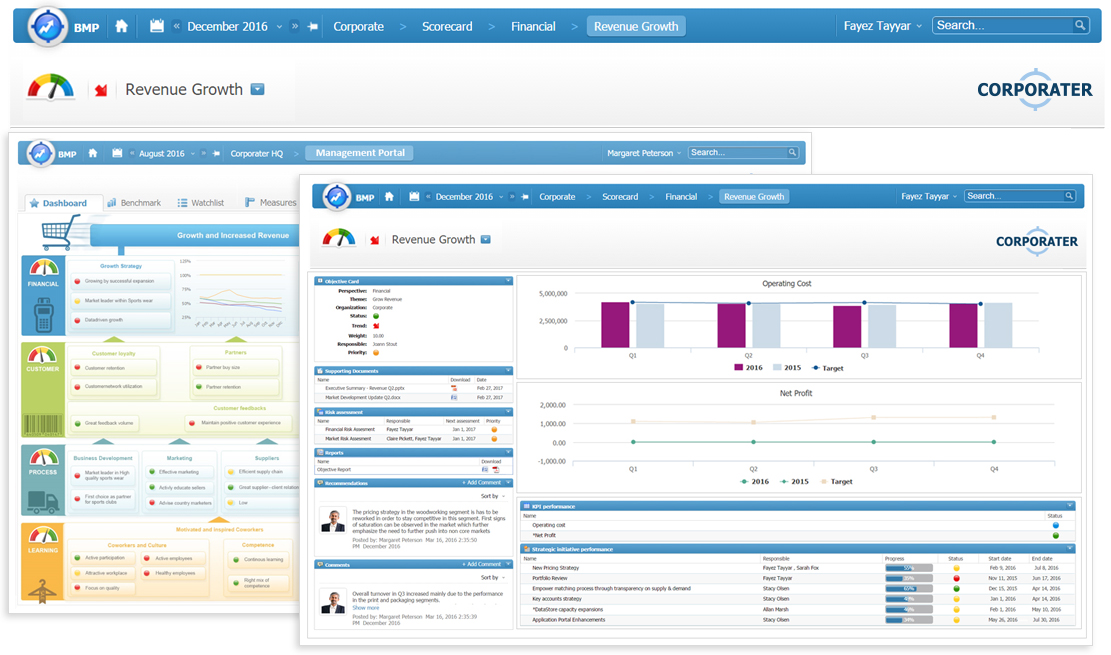
Source: Corporater
Below are some important features of Corporater.
Manage User Access
Implementing user access control and permissions is easy with Corporater, as it supports role-based access controls and their tracking. With this feature, you not only ensure that only authorized users have access to specific data, but can also ensure compliance with standards that require them. It brings down the risk of insider attacks as well.
Extensive Dashboards
Corporater comes with extensive dashboards that provide all the information you need in one place. It consolidates data from multiple sources like risk assessments, internal audits, incident reports, and more, and presents them in a visually appealing way. On this dashboard, you can find information related to KPIs, compliance rates, and actionable insights. Furthermore, you have the option to use the preconfigured dashboards to create custom ones to meet your specific needs.
Configuration Studio
Another key feature of Corporater is the option to easily configure and customize settings, modules, and functionalities to suit your specific needs. With its 250+ unique objects, you can adapt the solution to evolving requirements without any coding.
In all, Corporater is a highly customizable GRC platform that enables organizations to stay on top of their risks while ensuring compliance with industry standards and internal processes.
Pros:
- Highly flexible and works well across different business scenarios.
- Good technical support.
- Easy to monitor tasks and initiatives.
- Generates meaningful and actionable business intelligence.
Cons:
- Creating custom reports is time-consuming and requires technical expertise.
- No automation for configurations.
3. Vanta
Vanta is an AI-powered risk and security platform that automatically collects data and evidence from multiple sources and analyzes them to provide actionable insights. Its GRC capabilities are extensive and cover tasks, people (employees and vendors), processes, and technology.
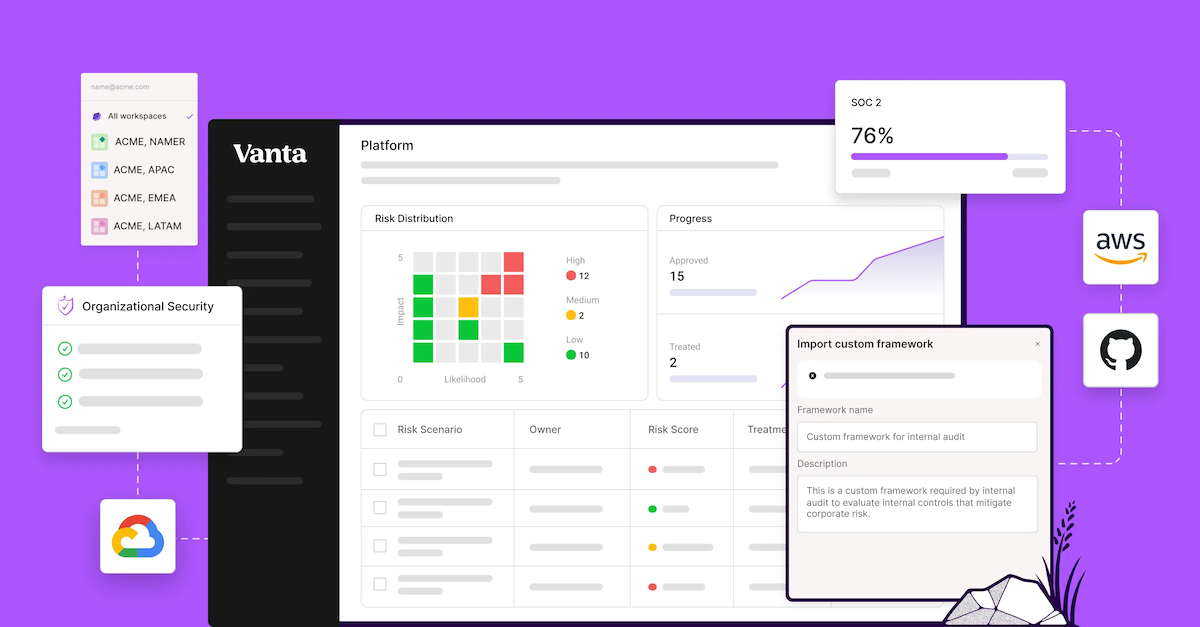
Source: Vanta
Here are Vanta’s salient features.
Automated Testing and Alerts
An advantage of using Vanta is its automated testing. You no longer have to manually collect data from different teams and managers and check for compliance. Vanta handles all of this automatically. It continuously collects data and evaluates them against existing controls, and alerts owners when there’s anything that falls out of the established compliance controls.
Manages Third-party Risks
Managing third-party risks and vendors is one of the most challenging parts of GRC, and Vanta handles this with its AI-driven processes. It uses automated questionnaires that third parties have to fill and the results are analyzed by AI to identify any associated risks. Additionally, it discovers the presence of shadow IT resources in third-party environments to analyze the potential impact on your organization. You can also use this tool to collect security documents from vendors for further analysis.
Prebuilt Templates and Integrations
Vanta comes with hundreds of prebuilt templates and content that you can leverage to kickstart your GRC efforts, as these templates are designed to adhere to a wide range of standards and regulations. Also, it integrates with many popular systems and applications to streamline recurring tasks.
Overall, Vanta reduces manual efforts and their associated errors while accelerating compliance and risk management.
Pros:
- Extensive support for complying with standards like SOC2.
- Comprehensive monitoring of people, processes, and infrastructure.
- API-driven capabilities for greater flexibility in connecting different applications.
- Well-developed actionable insights.
Cons:
- Limited customization.
- Steep learning curve.
4. Hyperproof
Hyperproof is a comprehensive tool for managing risks, tracking compliance, and assessing governance. It efficiently manages multiple risks and compliance requirements through a single pane to provide a comprehensive view of what’s going on within your organization.
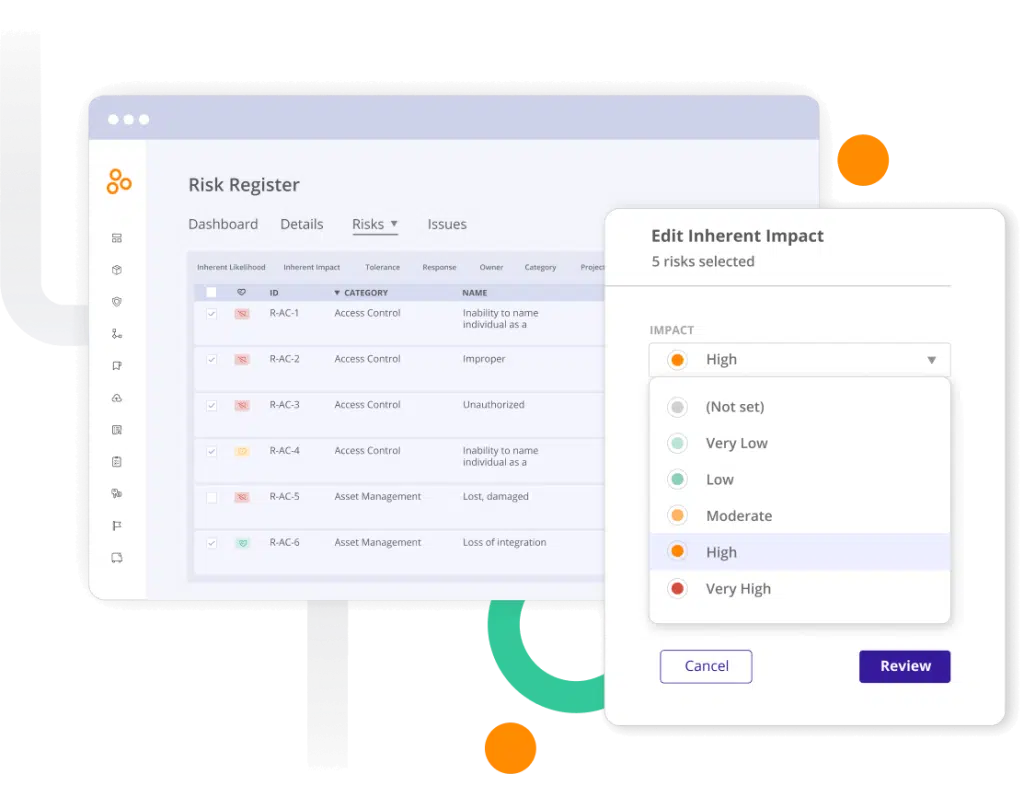
Source: Hyperproof
Let’s now explore Hyperproof’s key features.
Manage Compliance Controls
With Hyperproof, you have the flexibility to map the common controls with your changing compliance requirements. Besides the scalability advantage, it also automatically collects evidence of compliance to provide a snapshot of your organization’s compliance posture.
Identify and Prioritize Risks
Hyperproof gathers and analyzes all risk-related data in its central risk register. This process makes it easy to understand your risks and manage them effectively. You can even automate risk workflows, manage vendor risks, and track your organization’s risk posture over a defined time. Such options enable you to quickly mitigate risks and better protect your organization.
Prepare Audit Reports
Another important feature of Hyperproof is audit management and report generation. It automatically connects multiple audit requests to controls to help you generate reports quickly. Moreover, you can easily collaborate with your auditors and understand the status of your audit to ensure compliance with industry standards.
In all, Hyperproof can provide enterprise-grade security and streamlined governance and compliance to meet your organization’s specific needs.
Pros:
- Organizes multiple frameworks in a single place.
- Excellent customer support.
- Promotes collaboration within organizations.
- Integrates well with leading platforms and services.
Cons:
- Processes and terms are not self-explanatory
- Steep learning curve.
5. Compliancy Group
The Compliancy Group specializes in working with healthcare providers to help them comply with HIPAA, SOC 2, and OSHA guidelines. It is also a highly flexible solution that combines training and incident management as a part of compliance, making Compliancy Group the one-stop place for all your compliance needs.
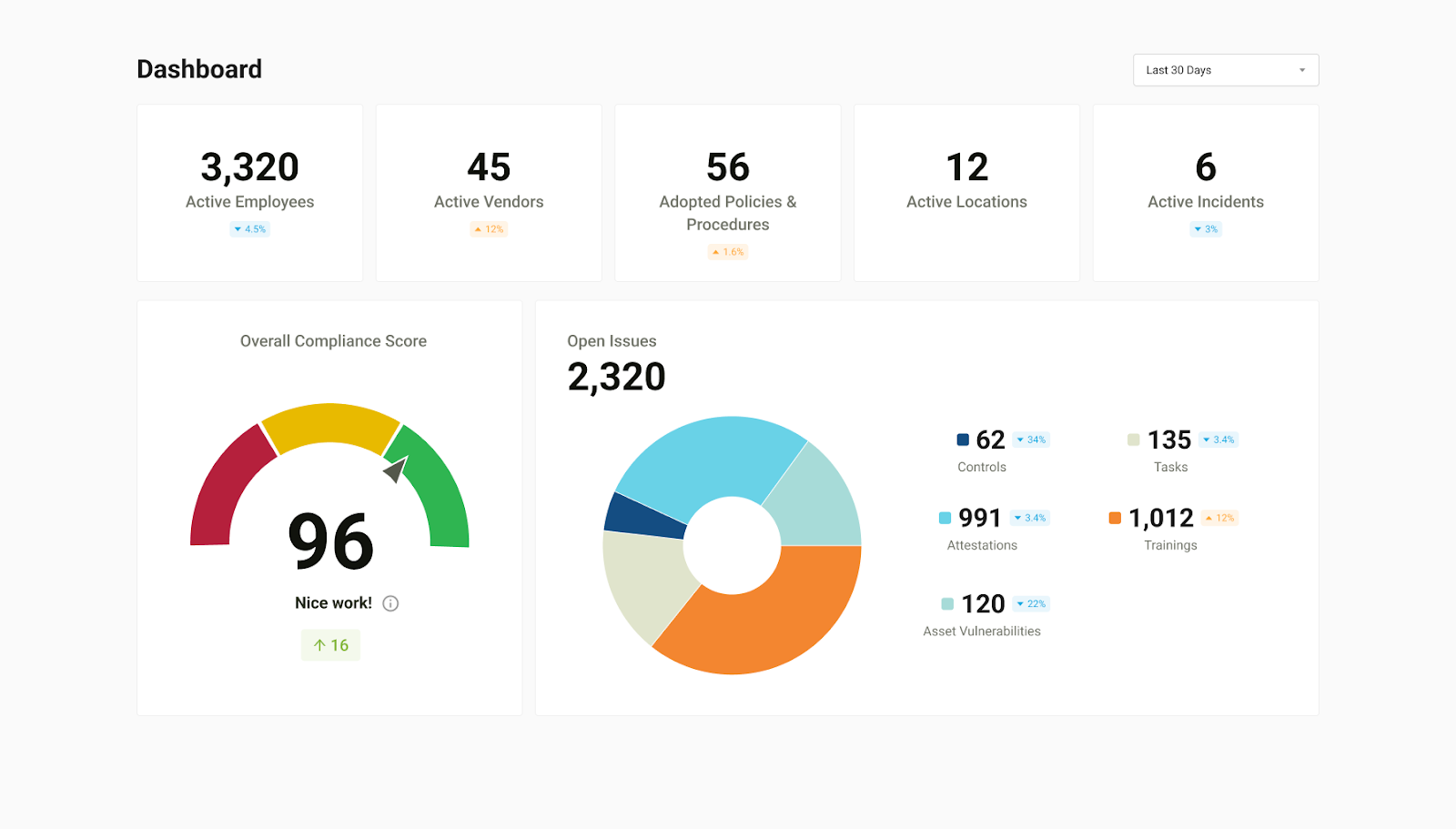
Source: Compliancy Group
Below is a brief description of what it can do for your organization.
Comprehensive Training
Compliancy Group trains your staff to understand and meet HIPAA standards. It also tracks the learning process and creates assessments to monitor their understanding. To motivate them further, it also offers personalized certificates for successful course completion.
Out-of-the-box Templates
The healthcare standards are one of the most rigorous in the world, and the Compliancy Group ensures adherence to them through different features. To this end, it offers templates to create and implement policies within your organization. It also has templates for monitoring the efficiency of these policies and their overall impact on meeting compliance standards.
Identify and Fix Gaps
Compliancy Group walks your organization through the six pillars of HIPAA and helps identify gaps in their compliance. Accordingly, it even creates remediation plans to bridge these gaps. You can also use this tool to report and manage incidents and through them, identify and fix vulnerabilities.
In all, Compliancy Group is a one-stop place for healthcare providers looking to comply with HIPAA, SOC2, and OSHO. Moreover, you also get a seal of compliance with these standards to earn trust among your customers.
Pros:
- Simple and streamlined processes.
- Well-developed training modules and sessions.
- Coaches were assigned to help with audits.
- Simple and intuitive UI
Cons:
- The certification and renewal process is lengthy.
- Hard to schedule sessions with customer support.
6. SAP GRC
SAP GRC provides a comprehensive set of tools and processes to help organizations assess and manage their risks and compliance with relevant standards. It also offers modules for risk mitigation, incident management, regulatory change management, auditing, and more.
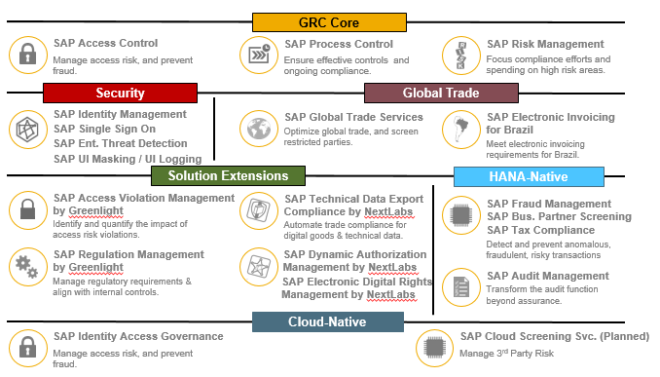
Source: SAP
Here’s a look at some key capabilities of SAP GRC.
Managing Enterprise Risk
SAP’s risk assessment and management modules help identify business risks. It also assigns a priority score for each to ensure that maximum resources are allocated for the high-priority risks. Also, it continuously monitors internal control processes and provides insights into how risk drivers can impact your business.
Streamlines Access
SAP’s access control module streamlines access management and ensures that only authorized users can access a resource. It also creates an automated process for user authorization to prevent disruptions to productivity. Its Identity Management module is designed to handle complex identities while reducing the risk of fraud.
Interactive Learning
SAP invests heavily in user training, and its GRC Solutions Learning Journey has all the content you need to get started with GRC. It is interactive and designed for users of all levels. Certificates are also awarded to learners who complete the course and pass the assessments.
Overall, SAP GRC is a modular approach to GRC, as you can select the modules needed to meet your organization’s specific needs.
Pros:
- Automates many processes related to risk and compliance.
- Addresses the critical challenge of identity and access management.
- Creates a uniform approach across all departments.
- Most workflows are prebuilt and easy to deploy.
Cons:
- Difficult to connect with non-SAP applications.
- Expensive and complex.
7. Protecht Group
Protecht Group is a comprehensive GRC platform that ensures business safety and compliance. It provides all the required tools in one place to identify and manage risks, meet the compliance requirements of relevant standards, and improve the overall efficiency and productivity of your organization.
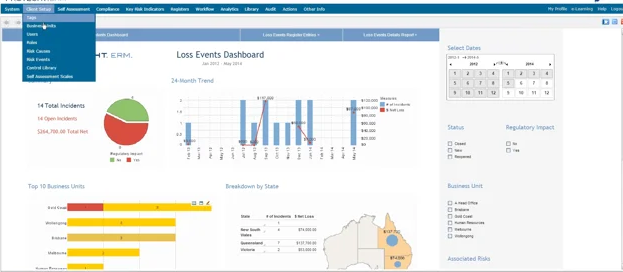
Source: Protecht Group
Below are the important features of this tool.
Well-designed Analytics and Dashboards
A highlight of Protecht Group is its intuitive and appealing analytics and dashboards. They are comprehensive and provide a complete picture of your business risks and profile. Using the information displayed on these dashboards, you can better understand your risk and compliance posture and make informed decisions to improve it. Also, these dashboards are customizable and can provide the key trends that matter the most.
Boosts Operational Resilience
Protecht Group offers complete visibility into your operations and helps you to stay prepared for external risks and threats. You can understand the impact of an incident or vulnerability and monitor the impact of your actions. Such visibility boosts operational resilience and provides business continuity.
Improved Compliance Management
With Protecht Group’s cohesive view of compliance, you can centrally manage all your obligations and even dynamically link relevant data and reports to each item. Such a comprehensive platform consolidates all your compliance-related documents and provides a single source of truth for the relevant users.
In all, Protecht Group provides the required tools for identifying risks and managing compliance within your organization.
Pros:
- Good customer support.
- Maintains complete transparency.
- Easy to configure and customize.
- Helps you to adapt easily to external changes.
Cons:
- Building out analytics requires technical expertise.
- Some parts of the UI can be clunky.
8. MetricStream
MetricStream is an AI-powered GRC solution that empowers organizations to make risk-aware decisions. It provides a modern and integrated approach to risk management while strengthening the compliance posture of your organization. Its focus on risk-based audits improves business performance and protects against evolving threats.
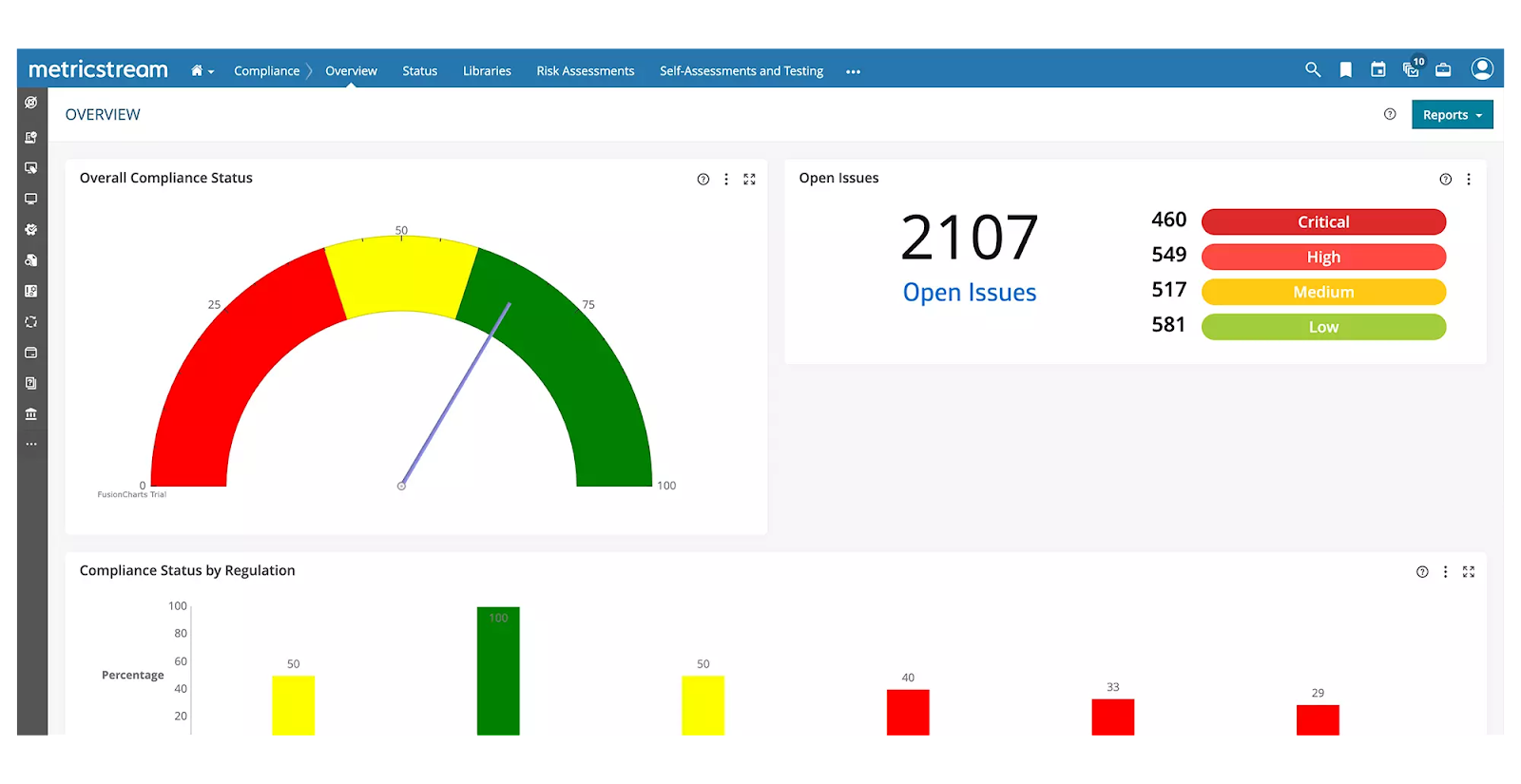
Source: MetricStream
Here’s a look at MetricStream’s important features.
Track and Coordinate Activities
MetricStream cuts across organizational departments and data silos to gather and track activities. Such a holistic view facilitates collaboration among teams and enables the organization to take a unified approach to tackling risks and uncertainties. It also helps to implement a unified set of rules within the organization.
Streamline Regulatory Compliance
Using MetricStream, you can stay on top of all compliance requirements, including cross-industry standards, localized laws, and evolving regulations. You can map your internal processes to meet these requirements to ensure that your organization is always compliant.
Agile Audit Processes
MetricStream provides the required information to create well-defined internal audit processes. It combines risk assessments, audit planning, scheduling, and other factors to create audit reports and follow up on the action items.
In all, MetricStream is a complete tool for gaining predictive insights into risk and compliance and creating action plans to stay one step ahead.
Pros:
- Supports incident management.
- Provides a common repository of GRC terms for easy understanding.
- Improves operational efficiency.
- Offers visibility into peripheral risks to help organizations prepare and mitigate them.
Cons:
- It does not track the activity of all vendors.
- Implementation is long and complex.
9. IBM OpenPages
IBM OpenPages is a unified GRC platform that can run on any cloud through IBM Cloud Pak for Data. It centralized all risks to provide the visibility and control you need to identify and mitigate them. Also, it is an AI-driven, scalable, and completely configurable GRC platform.
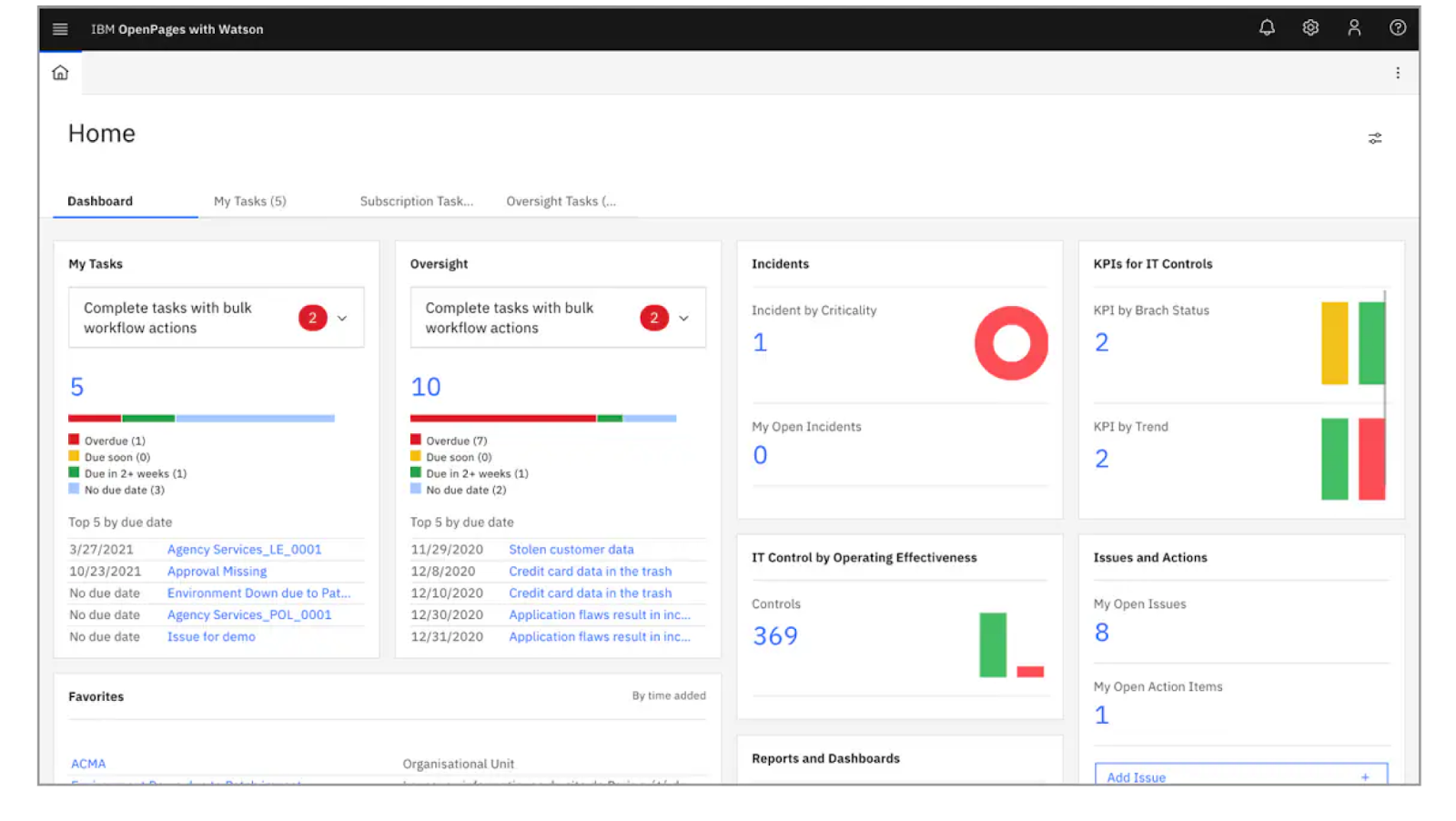
Source: IBM
Let’s take a peek into OpenPages’ capabilities.
Intuitive UI
IBM is well-known for its simple and clutter-free UI, and this extends to OpenPages as well. The UI provides a task-based view for every employee to help them stay on top of their actions. Such an approach even breaks down complex processes into action chunks for easy monitoring. Additionally, users can customize the UI to add heatmaps, relationships, and other dynamic fields.
Embedded Workflows
OpenPages offers many out-of-the-box workflows to address different use cases. You can even customize these workflows to meet specific scenarios. The interface has drag-and-drop functionality to easily create and modify them.
Risk Calculations
The Calculation Engine assesses and evaluates many factors to create a score for each risk. Based on this Key Risk Indicator (KRI), you can allocate resources for handling each risk. These scores also come in handy for internal auditing and compliance.
Overall, OpenPages helps identify, prioritize, and mitigate risks across the organization. In the process, it helps meet the compliance regulations and standards.
Pros:
- Records internal incidents.
- Extracts metadata for extensive text analytics.
- Scalable
- Supports large amounts of data.
Cons:
- Limited customization in reports.
- Limited integrations.
10. ServiceNow
ServiceNow’s GRC platform breaks down data silos to provide comprehensive views into your risks and compliance levels. Furthermore, it generates the insights you need to strengthen compliance and integrated risk management.
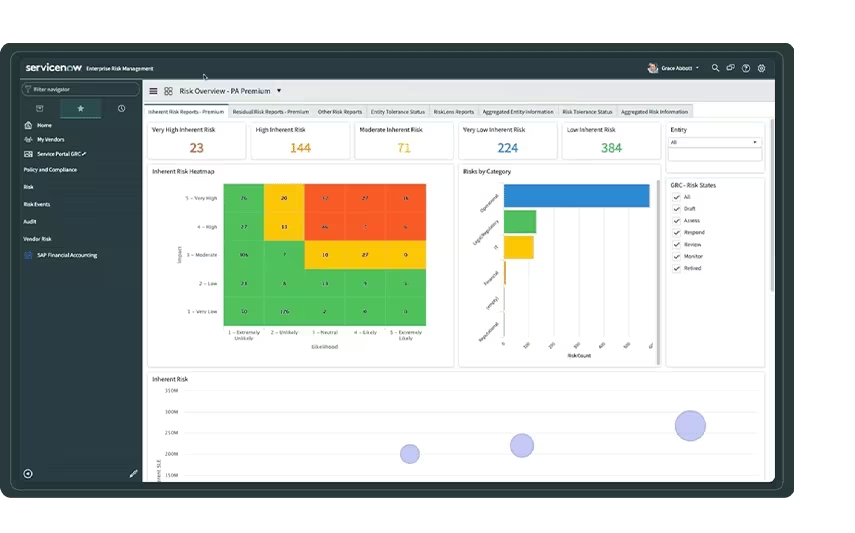
Source: ServiceNow
Below are the important features of ServiceNow.
Identifies Risks in Real-time
ServiceNow gathers business and IT service performance data to identify risks and include them in a centralized risk register for organization-wide visibility. Moreover, it identifies vendor requirements and creates automated controls to manage and mitigate these identified risks.
Defines a Governance Framework
This tool helps create and manage a governance framework that aligns with your compliance requirements and potential risk factors. It includes the industry-standard best practices, maps them to controls, and even automates repetitive processes.
Real-time Monitoring
ServiceNow specializes in real-time monitoring by identifying non-compliant controls, and high-risk areas. It automates the process of evidence-gathering and data validation to identify the KRIs and manage them. Also, its interactive dashboards provide a visual representation of these risks.
Overall, ServiceNow provides a comprehensive view of your risks and helps you manage and mitigate them, all the while meeting compliance requirements.
Pros:
- Monitors different risks in real time.
- Clear and concise messages.
- Includes privacy management
- Easy to use.
Cons:
- Custom workflows can be better.
- No performance analytics
Thus, these are the top ten GRC software platforms that can help you better manage your risks, create governance frameworks for unified policy implementation, and meet compliance with the relevant standards.
Conclusion
In summary, the growing risks and the emerging regulations to counter these risks make it difficult for organizations to stay on top of complying with them. This is where GRC platforms help as they help organizations identify risks and create governance policies to mitigate them. In the process, these tools also ensure that the policies meet the compliance requirements of different standards.
In this article, we discussed the best ten GRC tools, and we hope this information helps you pick the right one for your organization’s needs.
